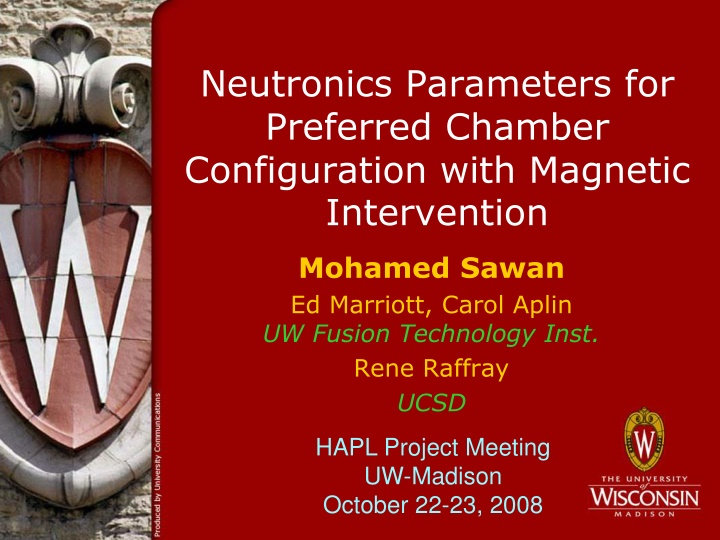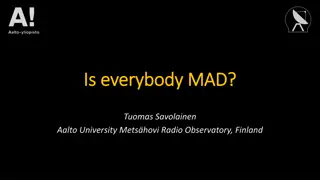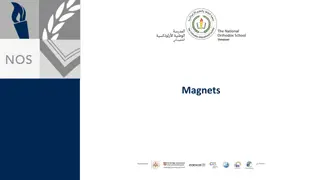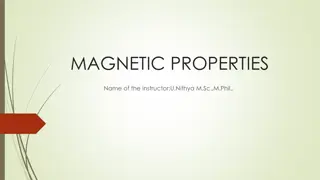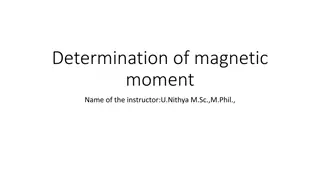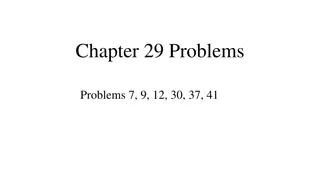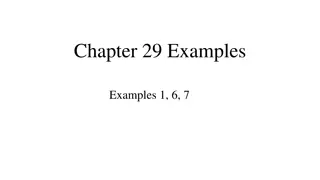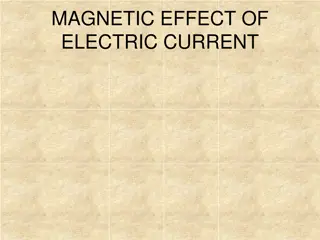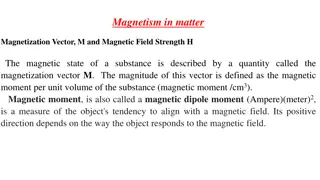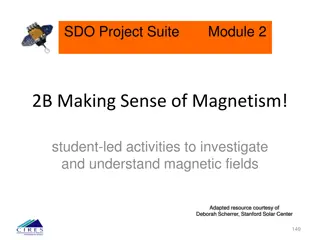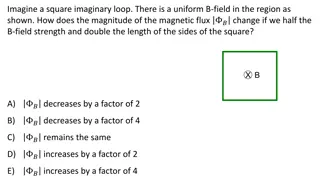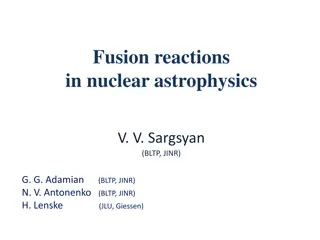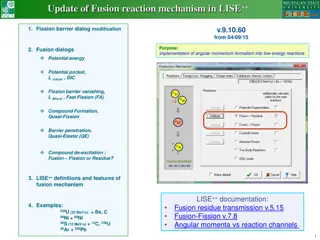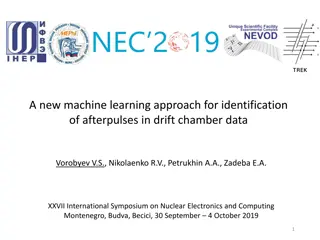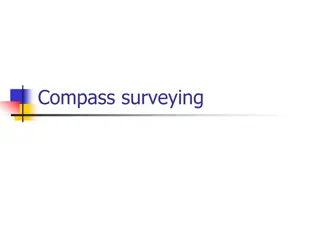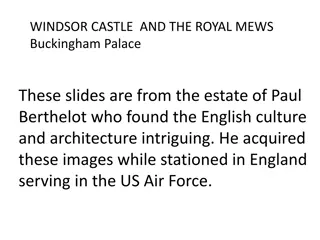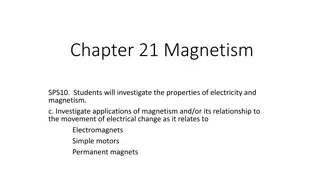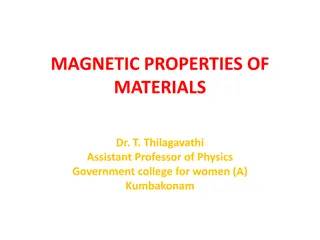Advanced Neutronics Parameters for Fusion Chamber Configuration with Magnetic Intervention
Detailed analysis and design considerations for a fusion chamber configuration utilizing magnetic intervention to optimize neutronics parameters. The discussion includes blanket configuration, neutron wall loading distribution, blanket design options, nuclear design requirements, and dimensions meeting all criteria. Tritium self-sufficiency, breeding blanket coverage, and component lifetimes are key considerations in this advanced fusion technology project.
Download Presentation

Please find below an Image/Link to download the presentation.
The content on the website is provided AS IS for your information and personal use only. It may not be sold, licensed, or shared on other websites without obtaining consent from the author.If you encounter any issues during the download, it is possible that the publisher has removed the file from their server.
You are allowed to download the files provided on this website for personal or commercial use, subject to the condition that they are used lawfully. All files are the property of their respective owners.
The content on the website is provided AS IS for your information and personal use only. It may not be sold, licensed, or shared on other websites without obtaining consent from the author.
E N D
Presentation Transcript
Neutronics Parameters for Preferred Chamber Configuration with Magnetic Intervention Mohamed Sawan Ed Marriott, Carol Aplin UW Fusion Technology Inst. Rene Raffray UCSD HAPL Project Meeting UW-Madison October 22-23, 2008
Blanket Configuration Top Blanket: 5 m above target 4.5 m outer radius 0.45 m inner radius Blanket Magnet Bottom Blanket: 5.2 m below target 3.2 m outer radius 0.45 m inner radius Shield Side Blanket: 4.5 m radius 13 m height 5 m above target 8 m below target HAPL Meeting, UW October 2008 2
Neutron Wall Loading Distribution (Top and Bottom Blankets) HAPL Meeting, UW October 2008 3
Neutron Wall Loading Distribution (Side Blanket) Peak Neutron Wall Loading is 5.4 MW/m2 in side blanket at target level HAPL Meeting, UW October 2008 4
Blanket Design Options Two blanket design options considered with low electrical conductivity SiCf/SiC composite structure (required for dissipating the magnetic energy resistively) LiPb/SiC Flibe/Be/SiC With Flibe a 1 cm thick Be insert is attached to back wall of FW coolant channel HAPL Meeting, UW October 2008 5
Nuclear Design Requirements Tritium self-sufficiency Overall TBR >1.1 Breeding blanket coverage lost by the two point cusps is 0.4% Breeding blanket coverage lost by 40 beam ports is 0.7% Total breeding blanket coverage lost is negligible 1.1% Shield and VV are lifetime components Peak end-of-life radiation damage <200 dpa Magnet is lifetime component Peak fast neutron fluence <1019 n/cm2 (E>0.1 MeV) Peak insulator dose <1010 Rads Vacuum vessel is reweldable Peak end-of-life He production <1 He appm HAPL Meeting, UW October 2008 6
Dimensions That Satisfy All Nuclear Design Requirements Flibe Blanket 100 7.5% Li-6 25 10 LiPb Blanket 80 10% Li- 6 45 10 Blanket Thickness (cm) Lithium Enrichment Magnet Shield Thickness (cm) Vacuum Vessel Thickness (cm) HAPL Meeting, UW October 2008 7
Tritium Breeding Flibe Blanket 1.204 0.151 LiPb Blanket 1.217 0.153 Local TBR Top Blanket Contribution to TBR (12.57% coverage) Bottom Blanket Contribution to TBR (7.16% coverage) Side Blanket Contribution to TBR (79.18% coverage) Overal TBR 0.086 0.087 0.953 0.964 1.190 1.204 HAPL Meeting, UW October 2008 8
Nuclear Heating Flibe Blanket LiPb Blanket Peak Nuclear Heating in Blanket (W/cm3) SiC Be Breeder 28 33 41 28 -- 80 Blanket Nuclear Energy Multiplication Top Blanket Nuclear Heating (MW) (12.57% coverage) Bottom Blanket Nuclear Heating (MW) (7.16% coverage) Side Blanket Nuclear Heating (MW) (79.18% coverage) Total Blanket Nuclear Heating (MW) 1.232 212.4 1.168 201.4 121.0 114.8 1338.0 1268.9 1671.4 1585.1 HAPL Meeting, UW October 2008 9
Peak Damage Parameters in Blanket Flibe Blanket LiPb Blanket Peak SiC Atomic Displacements per FPY C Sublattice (dpa/FPY) Si Sublattice (dpa/FPY) Average in SiC (dpa/FPY 40 42 41 83 63 73 Peak SiC Helium Production per FPY C Sublattice (appm/FPY) Si Sublattice (appm/FPY) Average in SiC (appm/FPY) 7,314 2,172 4,743 7,059 1,957 4,508 Peak SiC Hydrogen Production per FPY C Sublattice (appm/FPY) Si Sublattice (appm/FPY) Average in SiC (appm/FPY) 4 4 3,862 1,933 3,512 1,758 Peak SiC Burnup per FPY C Sublattice (%/FPY) Si Sublattice (%/FPY) Total in SiC (%/FPY) 0.32% 0.60% 0.92% 0.29% 0.54% 0.83% HAPL Meeting, UW October 2008 10
Peak Damage Parameters in Shield, Magnet, and VV Flibe Blanket 0.04 1.03x1018 LiPb Blanket 3.6 2.84x1017 Design Limit 200 1019 Peak EOL Shield Damage (dpa) Peak EOL Magnet Fast Neutron Fluence (n/cm2) Peak EOL magnet insulator dose (Rads) Peak EOL VV He production (appm) 3.39x109 4.32x109 1010 0.12 2.9 0.50 487 1 1 FS SS HAPL Meeting, UW October 2008 11
Summary and Conclusions All neutronics requirements can be satisfied with a Flibe/Be/SiC or a LiPb/SiC blanket in HAPL with the present magnetic intervention configuration Tritium self-sufficiency can be achieved for both blankets with overall TBR >1.1 ~5% higher blanket nuclear heating obtained with Flibe Peak dpa values in SiC are ~80% higher in LiPb blanket but peak gas production and burnup values are ~10% lower The shield is lifetime component and magnets are well shielded for both blanket design options The vacuum vessel is reweldable if it is made of ferritic steel If austenitic SS VV is used, it will be difficult to meet rewelding criterion with LiPb blanket while rewelding will be possible with Flibe blanket if thickness is increased by ~10 cm HAPL Meeting, UW October 2008 12
